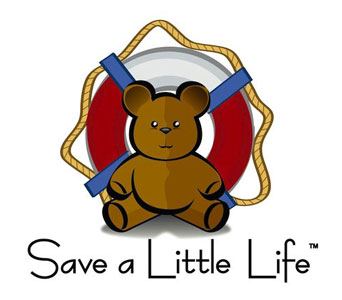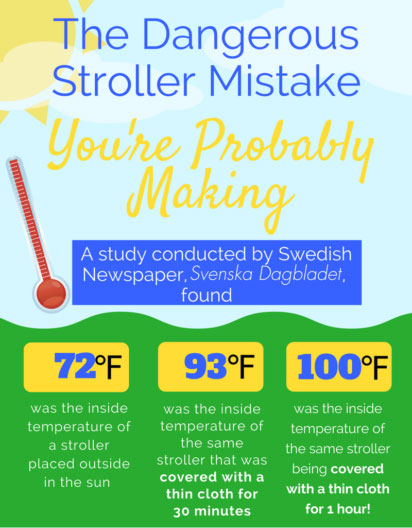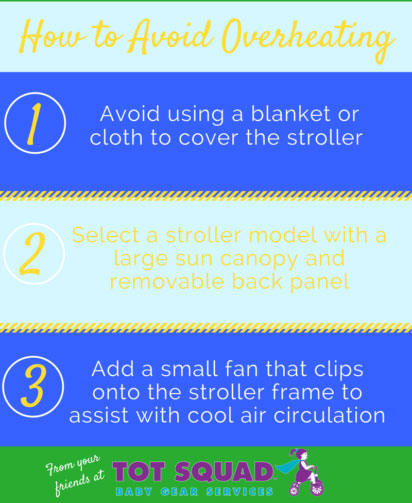In the blazing summer heat with the full sun bearing down on us, countless parents and caregivers drape a blanket over the stroller to give babies shade. It turns out, while we think we are protecting our little ones from the sun, we may be putting them at risk for heatstroke and SIDS (Sudden Infant Death Syndrome).
 Based on an interview with Stockholm pediatrician Dr. Svante Norgren about the dangers of covering a stroller, the Swedish newspaper, Svenska Dagbladet, conducted an experiment by putting a stroller out in the sun, midday, in the summer. Without a cover, the stroller was about 72 degrees Fahrenheit. After covering the stroller with a thin cover for 30 minutes, the temperature rose to 93 degrees and after an hour, 100 degrees!
Based on an interview with Stockholm pediatrician Dr. Svante Norgren about the dangers of covering a stroller, the Swedish newspaper, Svenska Dagbladet, conducted an experiment by putting a stroller out in the sun, midday, in the summer. Without a cover, the stroller was about 72 degrees Fahrenheit. After covering the stroller with a thin cover for 30 minutes, the temperature rose to 93 degrees and after an hour, 100 degrees!
Because babies sweat less, they are not able to adjust their body temperature as easily, compared to adults and older children. Their body temperatures can rise 3-5 times faster than ours. According to SIDS Australia, “Thermal stress (overheating) has been implicated in Sudden Infant Death Syndrome (SIDS) for many years and avoiding overheating has been one of the strategies to reduce the risk of SIDS.”
So how can you keep infants cool, safely?
Staying indoors during the peak heat of the day (between 10am and 3pm) can be helpful. If you must head outdoors, use a UV cover that doesn’t enclose the stroller, like a parasol. Look for strollers with large sun canopies, ventilated or removable back panel, and no excess cushioning. Air circulation is critical. Wide-brimmed hats are also a good way to protect them from the sun.  Dress children lightly, use plenty of sunscreen, and keep them well-hydrated. Sponge your child with a damp cloth to keep them comfortable. A small clip-on fan can be attached to their stroller for added circulation – just be sure to keep it out of reach.
Dress children lightly, use plenty of sunscreen, and keep them well-hydrated. Sponge your child with a damp cloth to keep them comfortable. A small clip-on fan can be attached to their stroller for added circulation – just be sure to keep it out of reach.
When in their stroller, check your baby to ensure they are not overheated. An overheated baby may sleep a lot. Ensure they are not sweating or are hot to the touch and head indoors if the sun and heat get too strong.
Article courtesy of our friends at

 Based on an interview with Stockholm pediatrician Dr. Svante Norgren about the dangers of covering a stroller, the Swedish newspaper, Svenska Dagbladet, conducted an experiment by putting a stroller out in the sun, midday, in the summer. Without a cover, the stroller was about 72 degrees Fahrenheit. After covering the stroller with a thin cover for 30 minutes, the temperature rose to 93 degrees and after an hour, 100 degrees!
Based on an interview with Stockholm pediatrician Dr. Svante Norgren about the dangers of covering a stroller, the Swedish newspaper, Svenska Dagbladet, conducted an experiment by putting a stroller out in the sun, midday, in the summer. Without a cover, the stroller was about 72 degrees Fahrenheit. After covering the stroller with a thin cover for 30 minutes, the temperature rose to 93 degrees and after an hour, 100 degrees! Dress children lightly, use plenty of sunscreen, and keep them well-hydrated. Sponge your child with a damp cloth to keep them comfortable. A small clip-on fan can be attached to their stroller for added circulation – just be sure to keep it out of reach.
Dress children lightly, use plenty of sunscreen, and keep them well-hydrated. Sponge your child with a damp cloth to keep them comfortable. A small clip-on fan can be attached to their stroller for added circulation – just be sure to keep it out of reach.